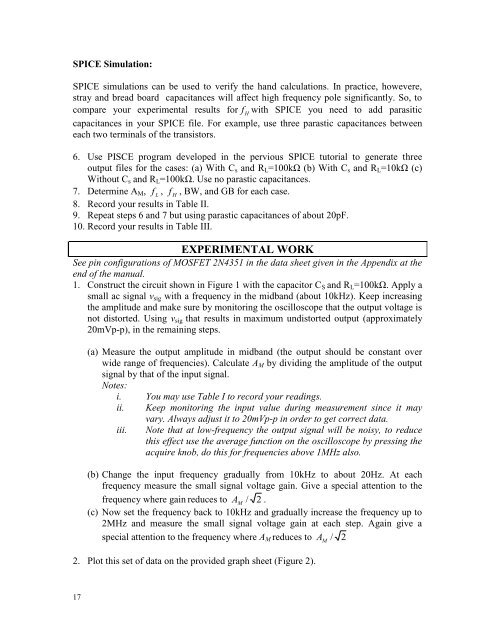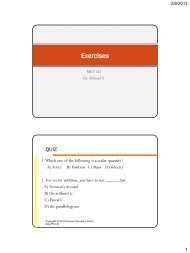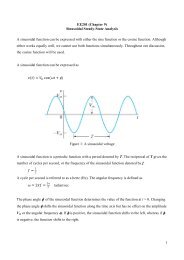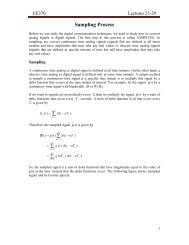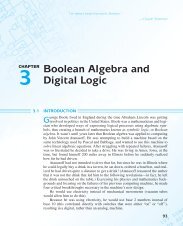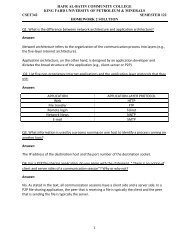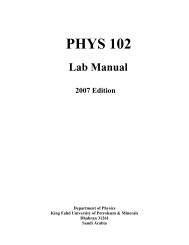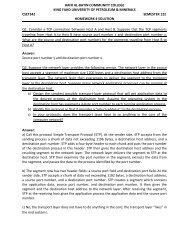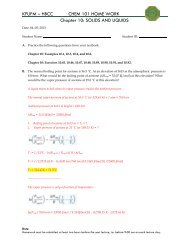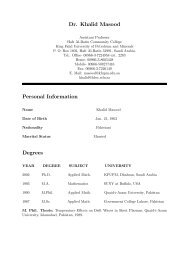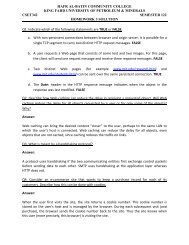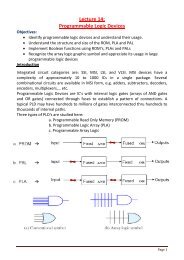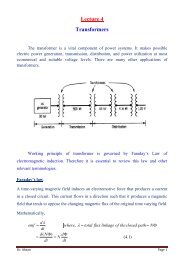Laboratory Manual - King Fahd University of Petroleum and Minerals
Laboratory Manual - King Fahd University of Petroleum and Minerals
Laboratory Manual - King Fahd University of Petroleum and Minerals
Create successful ePaper yourself
Turn your PDF publications into a flip-book with our unique Google optimized e-Paper software.
SPICE Simulation:<br />
SPICE simulations can be used to verify the h<strong>and</strong> calculations. In practice, howevere,<br />
stray <strong>and</strong> bread board capacitances will affect high frequency pole significantly. So, to<br />
compare your experimental results for fH<br />
with SPICE you need to add parasitic<br />
capacitances in your SPICE file. For example, use three parastic capacitances between<br />
each two terminals <strong>of</strong> the transistors.<br />
6. Use PISCE program developed in the pervious SPICE tutorial to generate three<br />
output files for the cases: (a) With C s <strong>and</strong> R L =100kΩ (b) With C s <strong>and</strong> R L =10kΩ (c)<br />
Without C s <strong>and</strong> R L =100kΩ. Use no parastic capacitances.<br />
7. Determine A M , f<br />
L<br />
, f<br />
H<br />
, BW, <strong>and</strong> GB for each case.<br />
8. Record your results in Table II.<br />
9. Repeat steps 6 <strong>and</strong> 7 but using parastic capacitances <strong>of</strong> about 20pF.<br />
10. Record your results in Table III.<br />
EXPERIMENTAL WORK<br />
See pin configurations <strong>of</strong> MOSFET 2N4351 in the data sheet given in the Appendix at the<br />
end <strong>of</strong> the manual.<br />
1. Construct the circuit shown in Figure 1 with the capacitor C S <strong>and</strong> R L =100kΩ. Apply a<br />
small ac signal v sig with a frequency in the midb<strong>and</strong> (about 10kHz). Keep increasing<br />
the amplitude <strong>and</strong> make sure by monitoring the oscilloscope that the output voltage is<br />
not distorted. Using v sig that results in maximum undistorted output (approximately<br />
20mVp-p), in the remaining steps.<br />
(a) Measure the output amplitude in midb<strong>and</strong> (the output should be constant over<br />
wide range <strong>of</strong> frequencies). Calculate A M by dividing the amplitude <strong>of</strong> the output<br />
signal by that <strong>of</strong> the input signal.<br />
Notes:<br />
i. You may use Table I to record your readings.<br />
ii. Keep monitoring the input value during measurement since it may<br />
vary. Always adjust it to 20mVp-p in order to get correct data.<br />
iii. Note that at low-frequency the output signal will be noisy, to reduce<br />
this effect use the average function on the oscilloscope by pressing the<br />
acquire knob, do this for frequencies above 1MHz also.<br />
(b) Change the input frequency gradually from 10kHz to about 20Hz. At each<br />
frequency measure the small signal voltage gain. Give a special attention to the<br />
frequency where gain reduces to A<br />
M<br />
/ 2 .<br />
(c) Now set the frequency back to 10kHz <strong>and</strong> gradually increase the frequency up to<br />
2MHz <strong>and</strong> measure the small signal voltage gain at each step. Again give a<br />
special attention to the frequency where A M reduces to A / 2<br />
2. Plot this set <strong>of</strong> data on the provided graph sheet (Figure 2).<br />
M<br />
17


